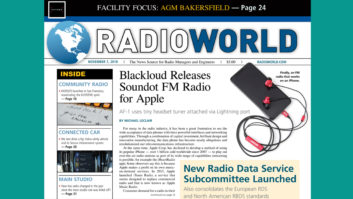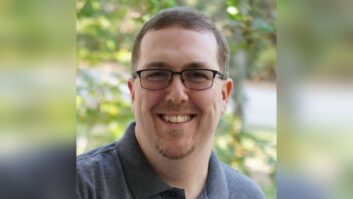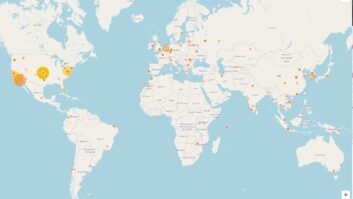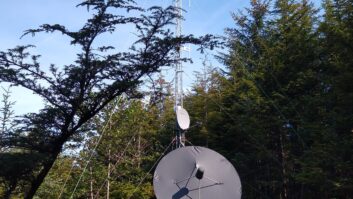American General Media, based in Bakersfield, Calif., is a broadcast and digital media company, owning and operating radio stations and media outlets throughout the southwestern part of the country, including Albuquerque, Santa Fe and Farmington in New Mexico; Durango and Cortez in Colorado; and, Bakersfield, San Luis Obispo and Santa Maria in California. It’s a family-owned company with 32 stations overall. Rusty Burchfield, a 21-year veteran of the company, is its corporate director of engineering.
A serious incident two years ago necessitated the rebuild of AGM’s Bakersfield facility. “The building in which all the studios are located was in a fire and deemed a complete loss,” said Burchfield. “However, all the stations still continued to operate and none went off-air, even during the fire. The staff continued to work in the building and we built the brand new facility while the stations were on the air. It was a bit of a juggle — a feat in itself.”
AOIP

Burchfield and Bill Bordeaux of Interstellar Communications (based in San Luis Obispo) designed and oversaw the construction of 12 new studios, most of which are built around Wheatstone IP-12 consoles, integrated into a WheatNet-IP AoIP system.
The IP-12 is a 12-fader control surface (as the name would suggest) and each of its input modules is equipped with an LED source name display and an A/B source selector (sources can be set via a rotary encoder in the master section). Each input module has access to four program busses and has cue and talkback switches. The master section has control room, studio and headphone controls with source selection, and an onboard headphone jack and amplifier. Timer controls, a master talkback button, and a built-in cue speaker with volume control are provided as well. There are four event switches and six programmable buttons available for user functions; the meter bridge has three stereo pairs of bright 30-segment horizontal LED bargraph meters.
The IP-12 control surface connects via Ethernet to its audio engine, the WheatNet-IP IP88CB console audio blade, a single RU device containing the console’s digital signal processing, input, output and logic circuitry. The engine has no fans and may be located either next to the console or at a remote location.

In addition to the IP-12s, four Radio Systems 12-channel consoles were installed and integrated in to the new studio system by way of various StudioHub accessories that allowed easy “plug and play” connections.
The studio builds were greatly simplified by the decision to use an AoIP system. “It was plugging in a Cat-6 cable and walk away. It was that simple,” said Burchfield. “And we built each studio, start to finish, in less than a day.” Between individual studios and the TOC Burchfield used all Cat-6 cabling. “So literally going from one studio to TOC is just a Cat-6 cable — from the console to a patch panel into TOC,” he said of system programming.

In addition to the 12 studios, Burchfield built a new technical operations center and made it a focal point of the facility.
“There are large glass windows in the front of the TOC so as you walk through the facility, either as a guest or as talent, you see all the large racks which are filled with blades,” he said. “There are a lot of really neat things to show as people come in to take a tour. Ultimately the TOC is something to take a look at — 12 racks full of equipment, servers, automation systems and just rack after rack of blades. It’s all nice, neatly, done. It’s a showpiece for sure.”
Burchfield used Wheatstone’s Navigator software to perform the original configuration of the system, and now uses it to make changes on the fly, as necessary, during the day to day operations of the station group.
“The way we designed it using Navigator is that any studio can essentially become whatever station you want, with a simple click of a button, which is very cool because we can move around on-air stations if we need to,” said Burchfield. “All the studios are exactly the same with exception of our talk studios, which of course contain blades, and those allow us to send out audio to anyone of the studios.

“On occasion politicians come in and want to do shows on various stations. You just put them in one of our talk studios, and using Navigator remotely with my cellphone, that audio can be routed into whatever other studio we want,” Burchfield said. “Or if someone wanted to listen to CNN in one studio, they can simply walk over to the accessible computer in the hall way by TOC, go to Navigator, and map that audio to their studio. They can use it for show prep, or just for monitoring, or what have you.”
He adds, “No more having to run down at 10 o’clock at night to resolve an issue with a satellite receiver. It’s simply a click of a mouse button, and you can map that audio anywhere from A to Z.”
SCOTT STUDIOS
I asked Burchfield about their automation system and the ways in which WheatNet-IP integrates with it. “We use Scott Studios automation systems, which hasn’t been supported since 2005. It’s antiquated, outdated — yet it integrated very well with Wheatstone product. Wheatstone gave us tips and tricks and knowledge on how to integrate with our new IP system, and it works great in fact. We aren’t even using sound cards anymore — it’s all over network cards using Ethernet,” he said. “If a studio fails, it’s not a problem at all because the audio is essentially coming from the TOC — and that was built with all kinds of redundancy.”

AGM Bakersfield provides programming for eight different radio stations. “Every station has its own streaming computer, and we didn’t have to do any wiring — we simply just installed their drivers and connected a Cat-5 cable to one of the network switches and now the audio is sent over the network using a blade,” Burchfield told me.
He also integrated his on-air processing systems with WheatNet. “The way we wired our technical operations center, using the Wheatstone software and hardware, allowed us to route that audio to our processing chain which then integrates with our microwave systems for our stations that use radio STLs,” Burchfield said. “We also integrated Wheatstone with some GatesAir IP Link systems, which is what we use for the stations that don’t have radio STLs. We really didn’t have to make any wiring changes or any change to our configurations of the STL and processing — all of that remained untouched. We simply just plugged a cable in, coming from the TOC.
“We use both Orban and Omnia on-air processors, and WheatNet-IP works with both of them. We also have a backup N+1 transmitter site that has a processor and STL at the studio that is fed by the audio network. Whatever we route to it goes out to this backup transmitter site. Before the WheatNet-IP installation, if one of the stations were to fail, either I or my assistant would have to talk someone through moving XLR cables around to get the correct feed. Now it’s simple — I go on my iPad or iPhone and via Navigator, I make the necessary changes.”
IP FEARS ABATED

I also asked Burchfield if, prior to their purchase and installation of the system, there were any reservations on the part of management. “We have a 50 kW AM station, KERN, the only one in town, and because it’s a historic station we were hesitant to switch because we were fearful of audio over IP. The owner was very hesitant, very fearful of making that change because IP relates to internet and so he had some reservations about it,” said Burchfield. “I explained to him how making this change will be seamless, and actually, when we did make the change, and went to Wheatstone, the audio actually cleared up and sounded even better than it did previously. It’s all digital from the studio all the way straight through to the transmitter.”
One feature that was added to AGM’s Bakersfield facility during the recent rebuild is a performance studio that can accommodate up to 150 people. “It’s a fairly large performance-oriented facility that we built in an adjacent building. There’s a stage, cameras and remote studios,” said Burchfield. “As artists are traveling to and from or up and down the state, we reach out to them and get them to come in and do interviews with our stations. We hope that they put on shows, and we’ve already had a couple. We then send the audio over the WheatNet-IP system to our websites and the video to YouTube and stream that so that viewers, listeners, can participate.
“We also built a really cool video green screen room — when artists are here we photograph them, and afterwards we can add artwork images behind them for marketing purposes and social media and that kind of thing,” Burchfield said.
Burchfield praised Wheatstone for its ongoing support. And he expressed pleasure at how many people, including other broadcasters, have wanted to tour the plant. “It’s nice, neat and clean, functional, state of the art, with room for advancement.”
Radio World is on the lookout for new or upgraded broadcast facilities to profile. Send your suggestions about studio or RF projects to [email protected].







